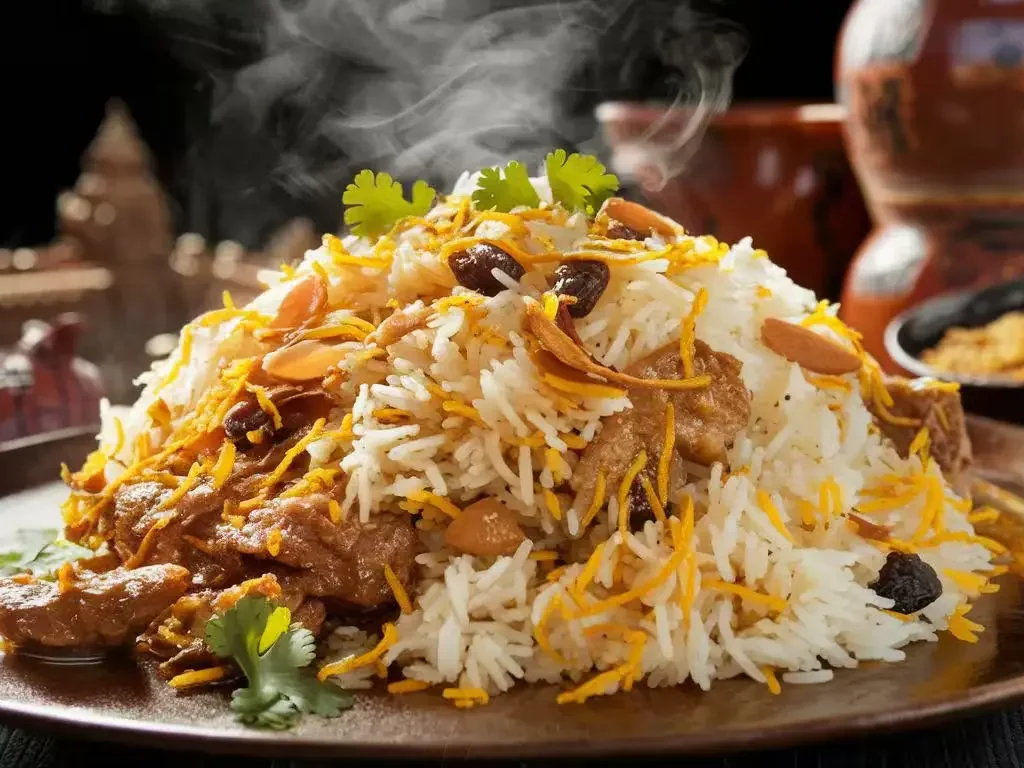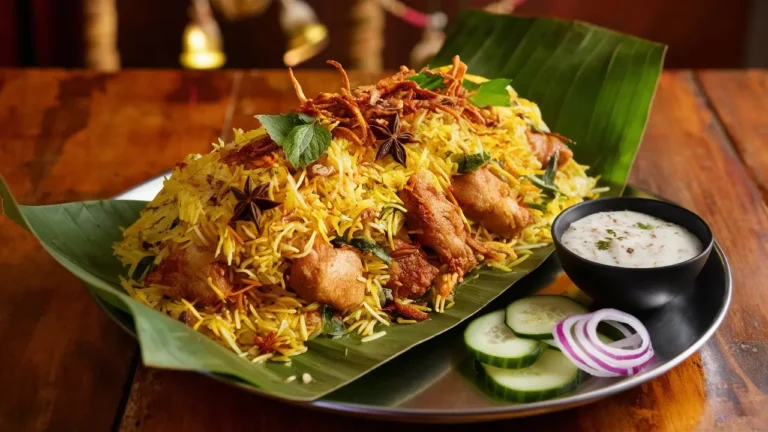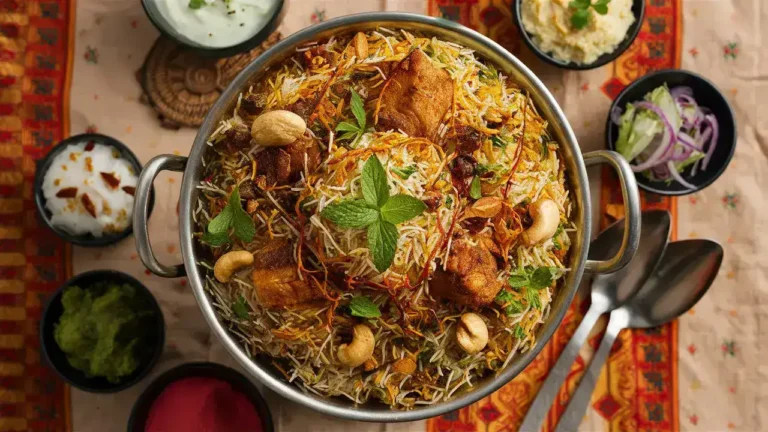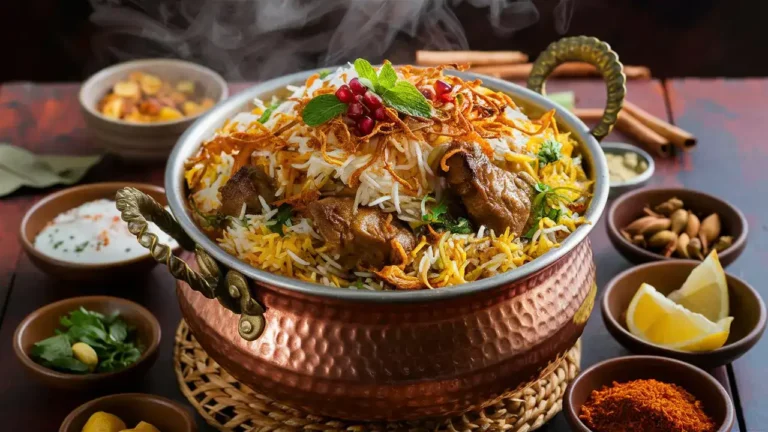Are you a foodie craving the rich, aromatic flavors of the legendary Hyderabadi Kabuli Biryani Recipe? Look no further! This delectable dish, hailing from the royal kitchens of the Nizam’s court, has captured the hearts and taste buds of countless individuals worldwide. Prepare to embark on a culinary journey that will transport you to the bustling streets of Hyderabad, where every bite of this biryani is a celebration of flavors. Get ready to master the art of cooking the authentic Hyderabadi Kabuli Biryani Recipe like a pro!
Hyderabadi Kabuli Biryani Recipe
The Hyderabadi Kabuli Biryani is a true masterpiece, a harmonious blend of succulent meat, fragrant basmati rice, and a medley of aromatic spices. This iconic dish has been passed down through generations, each cook adding their unique touch to the recipe while preserving its essence.
To understand the allure of this biryani, one must delve into its rich history. Originating from the kitchens of the Mughal Empire, the Kabuli Biryani found its way to Hyderabad during the reign of the Nizam rulers. Here, the local chefs infused their own culinary techniques and spice blends, creating a unique and unforgettable flavor profile.
What Makes Hyderabadi Kabuli Biryani Unique?
The Hyderabadi Kabuli Biryani stands apart from its counterparts due to several distinctive features:
- The Meat: Traditionally, this biryani is prepared with succulent pieces of mutton or chicken, marinated in a blend of yogurt and aromatic spices.
- The Rice: Aged, long-grain basmati rice is the star of this dish, carefully cooked to achieve the perfect fluffy texture.
- The Spices: A unique blend of spices, including cardamom, cinnamon, cloves, and saffron, imparts a captivating aroma and depth of flavor.
- The Cooking Method: The Hyderabadi Kabuli Biryani is cooked using the renowned dum pukht technique, where the biryani is steam-cooked on a low flame, allowing the flavors to meld harmoniously.
Ingredients Needed for Hyderabadi Kabuli Biryani Recipe
Before we dive into the recipe, let’s gather the essential ingredients:
For the Meat Marinade:
- 1 kg mutton or chicken, cut into bite-sized pieces
- 1 cup yogurt
- 2 tsp ginger-garlic paste
- 1 tsp red chili powder
- 1 tsp coriander powder
- 1 tsp garam masala
- 1 tsp salt
- 2 tbsp lemon juice
- 2 tbsp ghee or oil
For the Rice:
- 2 cups aged basmati rice
- 1 tsp salt
- 2 tbsp ghee or oil
- 4-5 cardamom pods
- 1 bay leaf
- 2-inch cinnamon stick
- 4-5 cloves
- 1 tsp shah jeera (black cumin seeds)
- A pinch of saffron (dissolved in 2 tbsp milk)
For the Biryani Masala:
- 3 medium onions, thinly sliced
- 2 tbsp ginger-garlic paste
- 2 tsp red chili powder
- 1 tsp coriander powder
- 1 tsp garam masala
- 1 tsp salt
- 2 tbsp yogurt
- 1 cup tomato puree
- 2 tbsp ghee or oil
- 1 cup mint leaves
- 1 cup coriander leaves
Step-by-Step Instructions
Now, let’s dive into the cooking process and create this culinary masterpiece!
Step 1: Marinate the Meat
In a large bowl, combine the mutton or chicken pieces with yogurt, ginger-garlic paste, red chili powder, coriander powder, garam masala, salt, lemon juice, and ghee or oil. Mix well and set aside to marinate for at least 2 hours (or overnight for best results).
Step 2: Prepare the Rice
Soak the basmati rice in water for 30 minutes. Drain the water and set the rice aside. In a large pot, add water, salt, ghee or oil, cardamom pods, bay leaf, cinnamon stick, cloves, and shah jeera. Bring the water to a boil, then add the soaked rice and cook until the rice is 70% done (al dente). Drain the rice and set it aside.
Step 3: Cook the Biryani Masala
In a large pan or kadhai, heat ghee or oil over medium heat. Add the sliced onions and fry until they turn golden brown. Remove half of the fried onions and set them aside for garnishing.
To the remaining onions in the pan, add ginger-garlic paste and sauté for a minute. Then, add red chili powder, coriander powder, garam masala, salt, yogurt, and tomato puree. Cook the masala until the oil separates from the mixture.
Now, add the marinated meat to the masala and cook for 10-15 minutes, or until the meat is partially cooked. Add the mint leaves and coriander leaves, and mix well.
Step 4: Layer the Biryani
In a heavy-bottomed pot or a handi, start layering the biryani. First, spread half of the partially cooked rice at the bottom of the pot. Then, evenly distribute the meat masala over the rice layer. Cover the meat masala with the remaining half of the rice. Sprinkle the saffron milk over the top layer of rice.
Step 5: Dum Cooking
Seal the pot with a tight-fitting lid and place it on a low flame. Cook the biryani for 20-25 minutes on low heat, allowing the flavors to meld together through the dum pukht technique.
Step 6: Garnish and Serve
Once the cooking time is up, remove the lid from the pot. Garnish the Hyderabadi Kabuli Biryani with the reserved fried onions and a sprinkle of fresh coriander leaves. Serve hot, accompanied by raita, mirchi ka salan, or any other desired accompaniments.
Hyderabadi Kabuli Biryani Recipe – Frequently Asked Questions
Q1. Can I use basmati rice instead of aged basmati rice?
While you can use regular basmati rice, aged basmati rice is preferred for its distinct aroma and fluffy texture, which enhances the overall flavor and experience of the Hyderabadi Kabuli Biryani.
Q2. How do I know if the meat is cooked properly?
When the meat is partially cooked, it should have a slightly firm texture but should not be completely dry or overcooked. The final cooking happens during the dum pukht process, where the meat will become tender and juicy.
Q3. Can I substitute ghee with oil?
Yes, you can use oil instead of ghee if you prefer. However, ghee imparts a richer flavor and aroma to the biryani, making it more authentic.
Q4. How do I make the biryani spicier?
If you prefer a spicier biryani, you can increase the amount of red chili powder in the marinade and the biryani masala. You can also add some green chilies or a pinch of cayenne pepper to the masala.
Q5. Can I make the Hyderabadi Kabuli Biryani in a pressure cooker?
While it’s possible to make biryani in a pressure cooker, the traditional dum pukht method is recommended for the Hyderabadi Kabuli Biryani. This slow-cooking technique allows the flavors to meld together perfectly and gives the biryani its signature texture.
Conclusion
The Hyderabadi Kabuli Biryani is a true culinary masterpiece that deserves a spot on every foodie’s bucket list. With its rich history, aromatic spices, and the perfect balance of flavors, this biryani is a feast for the senses. By following this step-by-step guide, you can recreate the authentic taste of this legendary dish in the comfort of your own kitchen. So, gather your ingredients, roll up your sleeves, and prepare to impress your guests with your newly acquired skills in cooking the best Hyderabadi Kabuli Biryani Recipe like a pro!
Did you enjoy Hyderabadi Kabuli Biryani Recipe Recipe? Follow us on Instagram @ketotacosalad for more delicious keto recipes and mouthwatering food photos!






